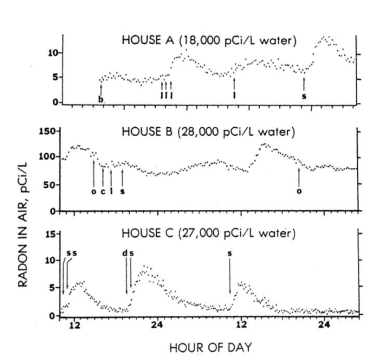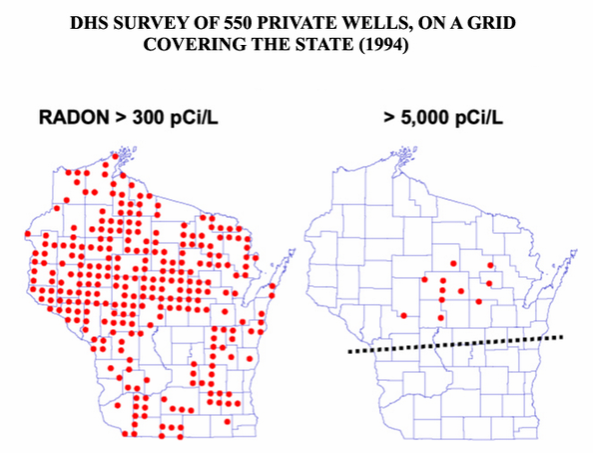Radon in Water
There is currently no U.S. Environmental Protection Agency (EPA) regulation for radon in drinking water, although the EPA has proposed a regulation as required by the 1996 amendments to the Safe Drinking Water Act. A 4000 pCi/L standard would apply for radon in community supplies in states that undertake a suitable program for radon in water and air. For the latest information on any regulation, see the EPA Radon webpages.
The National Academy of Sciences published a 279-page study, "Risk Assessment of Radon in Drinking Water" in 1999. The majority (90%) of the risk from radon in water is from inhaling the radon released from the water in household uses such as laundering and showering as illustrated on the graph to the right, where:
- s - indicates the time of a shower,
- l - laundry,
- b - bath,
- d - dishwasher,
- o - open window, and
- c - close window.
For every 10,000 pCi/L in a household water supply, a time average of about 1 pCi/L of radon is added to the air. The lifetime inhalation risk from 10,000 pCi/L in water (or one pCi/L in air) is about two in a thousand for never-smokers and about nine in a thousand for smokers. The lifetime ingestion risk (primarily stomach cancer) from 10,000 pCi/L is about seven in ten thousand.
EPA's proposed standard is only for community wells. However, the EPA has advised that if you use a private well and your indoor air has over 4 pCi/L, you may want to test your water for radon. If your well had 10,000 pCi/L, that could be responsible for about one pCi/L in your air.
In a survey of more than 500 private wells located in a grid covering Wisconsin, none south of a line from La Crosse to Green Bay had radon over 5,000 pCi/L (right). Devices for removing radon from well water for a single house are cumbersome, complex, and expensive, costing $3,000 to $5,000 for installation and 10 years of operation. The low risks avoided with one may not be worth the cost to a homeowner unless the water radon level is many times 10,000 pCi/L.


